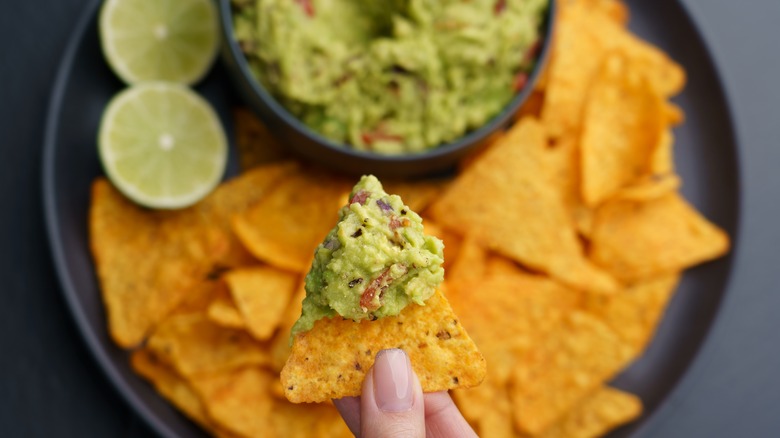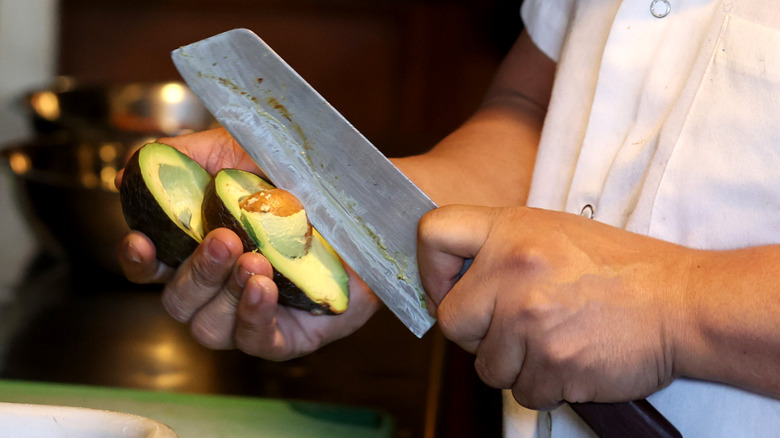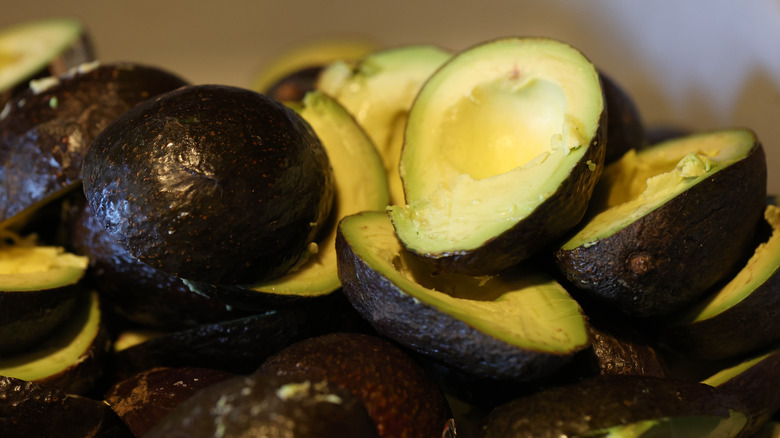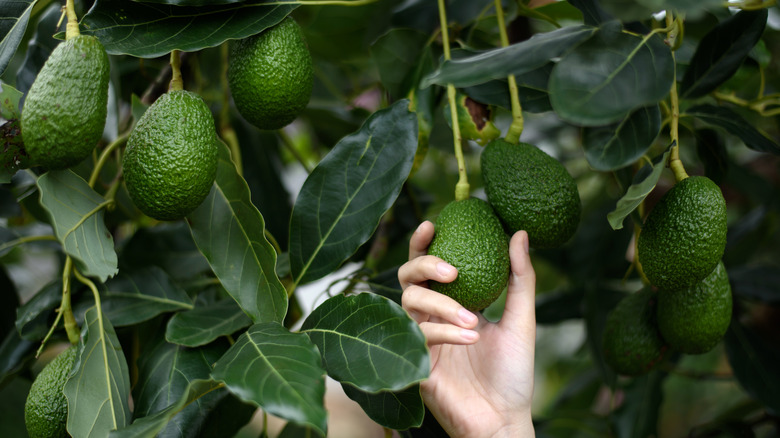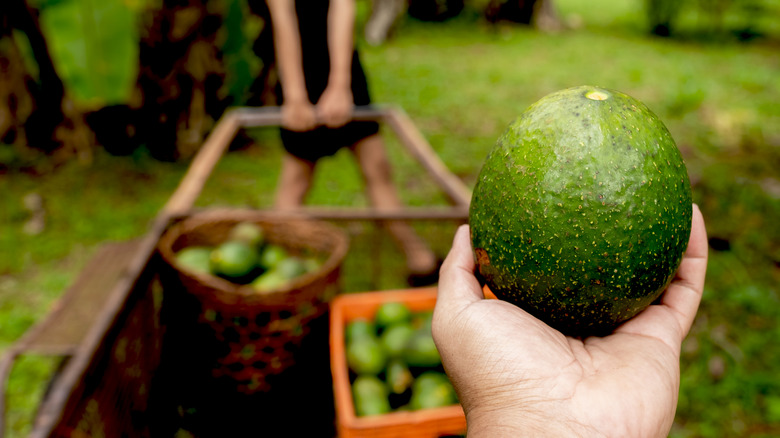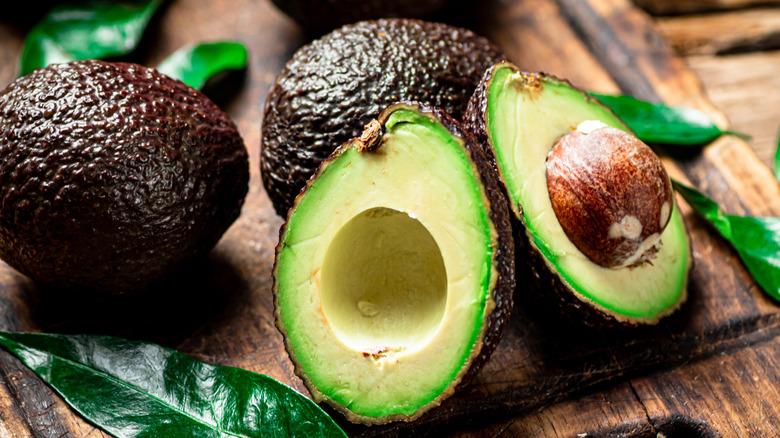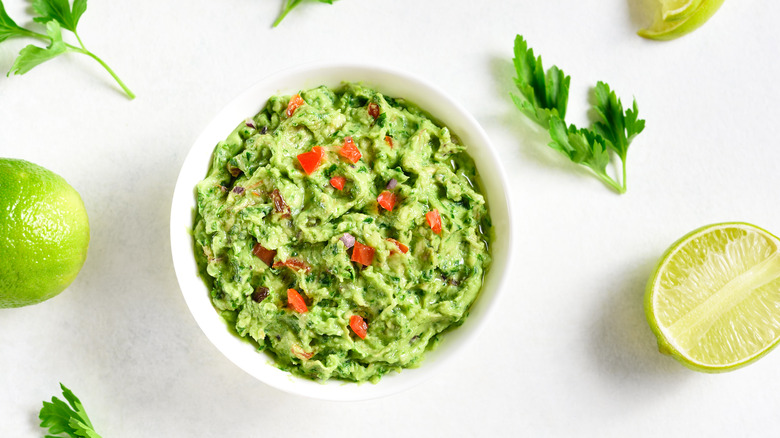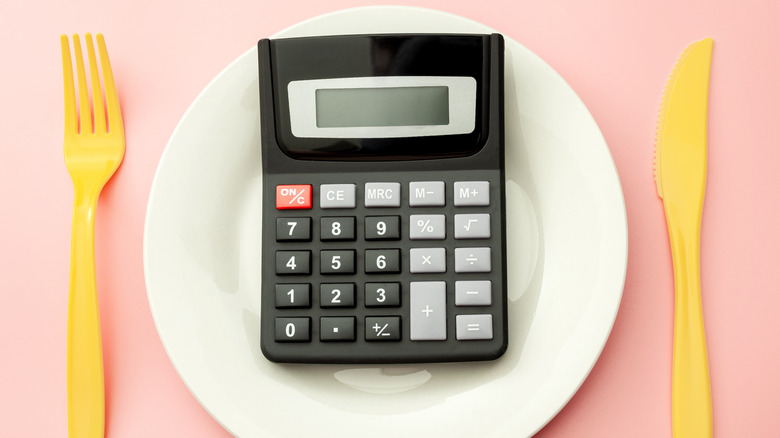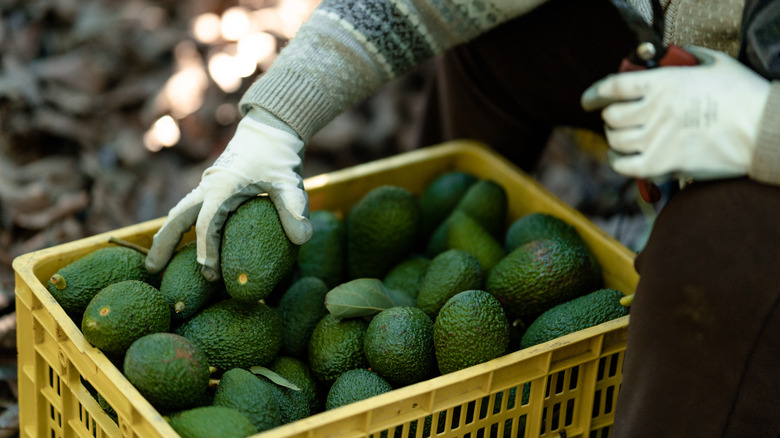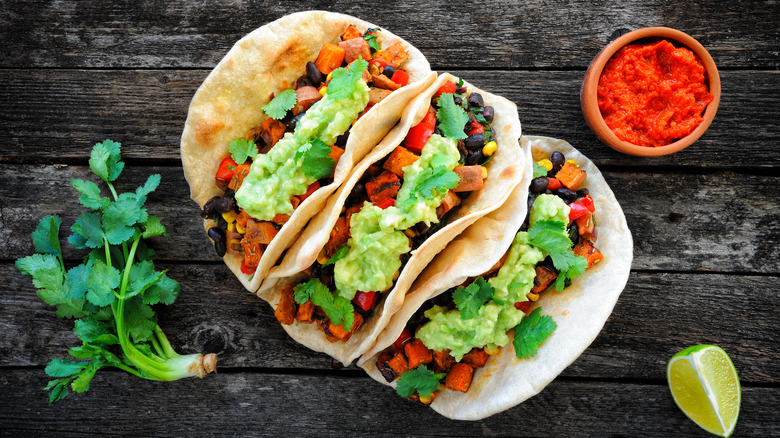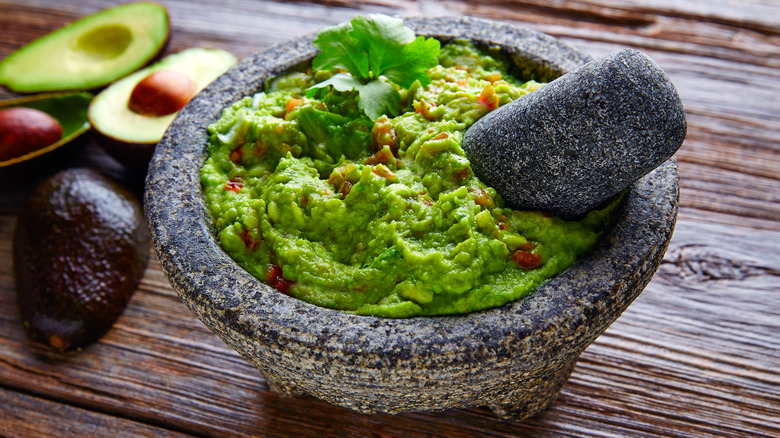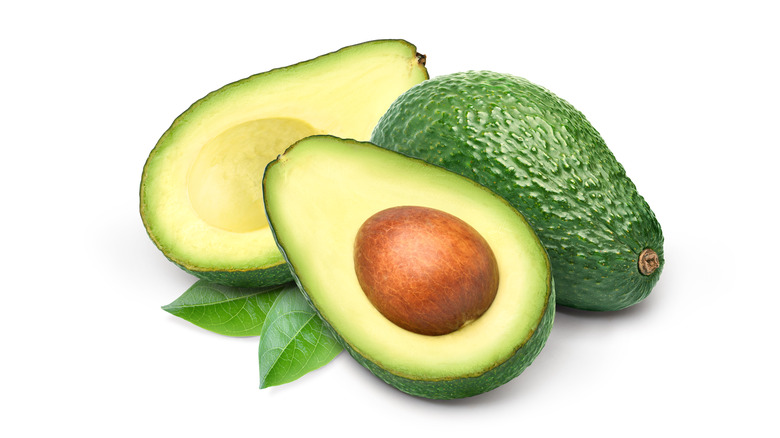Here's Why Guacamole Always Costs Extra In Restaurants
Though the terminology is often disputed, guacamole is usually described as a dip or a spread, but with such a versatile character, it makes a great accompaniment to any protein, and it easily blends into many savory dishes. This avocado-based specialty is packed with fat and fiber and usually represents a healthier option at most restaurants. It is entirely plant-based, and the typical additions, along with avocado as its star ingredient, include peppers, onions, herbs, and usually a splash of citrus juice. Of course, you can treat it as a blank canvas. The creamy and smooth avocado can be effortlessly built upon with any ingredient you prefer and consider suitable.
Despite its Mexican origin, guacamole has a very loyal fan base in the U.S. and is no longer solely associated with Mexican-inspired restaurants. You will often see it featured in casual establishments, diners, and on the menus of plant-based restaurants.
What you will also commonly encounter is the extra charge for a portion of guacamole. Though many think that sauces and dips should not be an added cost to your order, there are several reasons why charging extra for guacamole is a perfectly reasonable decision.
Restaurant-style guacamole is labor intensive to make
One thing that needs to be considered when it comes to the final cost of the restaurant guac is the time and work that goes into making consistent, uniform batches of fresh guacamole daily. Glancing at the Chipotle-like guacamole recipe, we often forget the preceding work of slicing, removing the pit, and scooping avocado meat out of the shell. If you try to recreate the recipe at home, this might not be such a challenging task, but for the large batches made at restaurants, you will need skilled and efficient staff that will spend a good part of their shift doing all the prep work.
In a viral TikTok video, a Chipotle employee answers several questions about the restaurant's famous guac and shows the entire prepping process. Apparently, it takes three to four people to do the whole process, and it takes approximately an hour to dish out five portions of guacamole. Another Chipotle employee filmed the entire process and posted the video on YouTube, showing that all avocado is smashed by hand and the additions are incorporated manually. If you also add the time it takes to slice and chop onions, cilantro, and jalapeños, it turns out that making restaurant guac in-house is a time-consuming process, and somehow that extra cost doesn't sound so unreasonable anymore.
Restaurants use massive amount of pricey avocado to make guacamole
Avocados are generally classified as expensive fruit with an unstable and constantly fluctuating market price. In such an unpredictable environment, it's hard to calculate the final cost that would remain profitable, especially if the fruit is used for a dish with such high demand as is the case with guacamole in the U.S. Though CNN reported that the avocado prices have reduced in the second half of 2022, and are probably going to stay that way through the first half of 2023, any unfavorable climate conditions could quickly disrupt the market and increase the price. For the regular consumer, the drop or increase is moderately noticeable, but for restaurants that go through a massive amount of avocados, market changes significantly affect profit.
To better illustrate this, it's best to look at Chipotle, the franchise known for its hand-mashed guacamole. According to the official press release, Chipotle goes through 450,000 avocados in one day to cater to the high customer demand, and the restaurants approximately sell more than 50 million pounds of guacamole every year. These massive numbers show that it would be difficult to stay profitable if all that guacamole were added at no extra cost, even more so because the "free of charge" label would inspire more people to include it in their dishes.
It takes approximately 60 gallons of water to produce one avocado
If you've ever wondered why avocados are so expensive, the easiest explanation is that they are simply difficult to grow and require an astonishing amount of water. Avocado has one of the largest water footprints, and approximately 60 gallons of water is required to grow one avocado fruit. Of course, this depends on where the fruit is grown, but generally, avocado falls in the less-desirable category of fruit that needs plenty of water to grow and ripen successfully.
Ideally, one portion of guacamole will include two tablespoons, an amount that will usually be made with 1/3 or half of a smaller avocado. Even if you don't add other costs to the equation, the sheer amount of water will be a good reason why avocado, and guacamole as its favorite byproduct, always cost more than other menu items and is rarely a complimentary dish at restaurants.
You're also paying for shipping and import costs
The demand for avocados in the U.S. is continually high. According to research published by Statista, in 2021, every American ate roughly 8.43 pounds of fresh avocados. Though the popularity of avocados slightly diminished in comparison to 2020, avocado is still a coveted crop among Americans. The only problem is that the U.S. cannot cultivate enough avocados to meet the demand. Though you might have seen Californian avocados occasionally, a USDA study revealed that more than 90% of avocados consumed in the U.S. are imported. Unsurprisingly, most of the import comes from Mexico.
If you're wondering how this relates to the extra cost of your guacamole, let us illustrate. If you are shipping an item from a different country, you're not only working with the cost of agricultural production; by adding shipping expenses, transportation, and a myriad of import fees, you will get a number that won't even come close to where it started. Guacamole, as the final product, will inevitably be affected by these additional expenses.
Good guacamole has to be made with fresh avocados
Despite our love for avocados, we can all agree that this is one complicated and finicky fruit. It is a tricky beast to cultivate as it needs perfect conditions to ripen, and once you cut into it, you better eat it fast, as avocados have a short life span in the fridge. In no time, the vibrant green color will turn into an unattractive dark brown mess, and the oily juiciness will suddenly disappear. And if you think that keeping a batch of avocados alive at home is a problem, things get even more serious in a restaurant environment.
Avocados start the ripening process once harvested and need to be shipped immediately. Shipping conditions need to be ideal as warmer temperatures may speed up the process, resulting in an overripe and already oxidized batch of avocados by the time they reach their destination. Once the restaurant receives the order, there is no way to stop the ripening process or preserve avocados, and they need to be used as soon as possible. Because they are so perishable, avocados are a liability for the business and require proper handling and effective time management. There is no way to mask avocados; you need to have them in perfect condition to make fresh guacamole. All of these instances will certainly affect the decision to charge extra, as it took time, money, and effort to have it served in the perfect condition.
Other ingredients in the guacamole add to the cost
Another element we're missing in the "why pay extra for guac" calculation is the cost of other ingredients. As you know, guacamole isn't simply mashed avocado; you need additional elements to add flavor, spice things up, and make the smooth texture a bit more exciting. In the classic restaurant guacamole, you would typically add a splash of lime or lemon juice to balance out all the creaminess. The acidity would also keep guacamole green for longer. Besides citruses, standard guacamole would include diced red onions and jalapeños, which provide crunch and bring the extra flavor kick. Finally, chopped cilantro is a typical herb that you will find in most restaurant-style guacamoles. Though it is a divisive ingredient, cilantro will give guac a vegetal note that works so well with avocado.
Of course, these are only some basic guacamole additions, and you will find many examples that add tomatoes or other chili peppers. Let's also not forget the seasonings. Though we're not talking about some lavish or crazy expensive ingredients, when it comes to numbers, even minor costs need to be included in the calculation.
The decision to upcharge for guacamole can also depend on other restaurant expenses
If you're still baffled why that serving of guacamole will cost you extra, you need to remember that your homemade guacamole doesn't come at the same price as the restaurant version. Running a restaurant is a complicated affair, and many expenses remain invisible to the customer as the end user in the process.
Rent, utilities, equipment, certificates, payment options, and additional services such as bookkeeping and marketing will all impact the final cost of the dish. In the end, you're also paying for the service, which is a big part of the experience. This all adds to labor and the overall cost of ingredients, creating a complex financial riddle that will affect menu pricing. After reading this, you'll probably want to pay extra for a dollop of guacamole that you like to have on top of your taco. It comes freshly prepared, and you are paying for all the background effort that made it happen.
The extra cost could mean that avocados came from a sustainable source
Avocado may be one of the favorite tropical fruits, but it has a big problem with sustainability. Along with the massive water footprint, the cultivation of avocados has other sustainability issues. Most of the avocados consumed in the U.S. come from Mexico, which is also one of the biggest avocado producers in the world. The sudden demand for avocados has resulted in increased production in avocado-growing regions of Mexico, and it has come with a high cost of illegal deforestation, environmental destruction, and gang-related incidents (via The Guardian). Though harvesting avocados can be a profitable agricultural investment, unregulated production, and the black market will inevitably negatively affect the industry and the environment.
However, like any crop, avocado can also come from reliable, environmentally conscious suppliers, but this could also mean that it will come at a slightly higher price. So, the next time you order a batch of guacamole and see that you will be charged extra, think about the background story. The extra cost might be a good sign that avocados came from a trusted source and that your love for guacamole will not have an additional damaging impact on the environment.
Guacamole is used to customize a meal and it's not an integral part of the dish
What most people get wrong about guacamole is that it is not an integral part of the dish. It is either an accompanying sauce, dip, or condiment that is added to tacos and burritos to provide extra flavor. Guacamole is here to modify your meal and make it better, but it always costs extra because it wasn't part of the original order. It is usually offered as an optional choice because not everyone appreciates and likes to see guac inside the burrito, so offering it for additional cost seems reasonable.
The extra charge might also discourage unnecessary food waste. People often grab things if they're labeled "free of charge" just because they can, regardless of how much they like it. In the case of guacamole, we're talking about a dish that is made with a pretty expensive and perishable main ingredient, and if a significant portion ends up in the trash, it will reflect negatively on the restaurant's profit.
This is best seen in a seemingly endless rivalry between QDOBA and Chipotle. Though QDOBA likes to hype their free guac, the comments on social media tell a different story. In comments on a Facebook post, customers mentioned that they'd rather pay extra for high-quality guacamole than eat a subpar version, even though it is free.
Tableside guacamole is even more expensive
Even if you finally accept the extra cost of that guac that comes with your order, you might be surprised that there is one guacamole variety that will sometimes set you back at approximately $20. In comparison, the typical cost of a guac order at a fast-casual establishment such as Chipotle will be around $2.50, while a standard portion of chips and guac typically doesn't go over $5.
Tableside guacamole is the superior guac version, both in flavor and price. The typical technique involves a server who pushes a trolley filled with standard guacamole ingredients to the dining area, and then mashes and creams the whole thing in front of the guests. This also allows easy customization, which is a great opportunity to leave out cilantro if it doesn't please your tastebuds. The price of tableside guac is typically much higher because you're paying for the freshness. Most restaurants make standard guacamole once or twice in one day, whipping up large batches that are then portioned through the daily service. This means that sometimes your guac might have spent too much time sitting on the counter. With tableside guacamole, you will surely get the freshest possible version, but that superb quality comes at a price.
Avocado is still promoted as a superfood
Due to their rich nutritional profile, avocados are often promoted as a superfood ingredient. Mayo Clinic explains that these green fruits pack at least 20 nutrients, including vitamins, minerals, and fiber. They are also known for their considerable fat percentage, mainly coming from the "good" monosaturated type. Despite the calorie count and the fat content, avocados are considered a valuable food item that will provide plenty of plant-derived nutrients, and all the fat and fiber will nourish, energize, and make you full for longer.
As it's often classified as a superfood, avocados will usually dictate a higher price, which means that the cost of guacamole will also be affected by this status. Though the term superfood is mainly used as a marketing ploy, promoting any ingredient as superior in nutritional profile and the supposed health benefits will certainly affect the price and the sales, which is always welcomed in the competitive food market. Blueberries and kale are the best examples illustrating how an everyday ingredient became drastically more popular after it was upgraded into the superfood category.
Customers are willing to pay extra
You've probably noticed that eating out has become more expensive these days. Yahoo reports that the latest Consumer Price Index for 2022 shows a price increase of 8.3% when it comes to eating outside of the house. Despite this significant rise, the ratio between eating out and preparing meals at home was always straightforward; you save more money by staying in and making your own dinner. However, not everything comes down to money, and customers who like eating out don't mind paying for the experience and service.
Yes, you can make that guacamole for much less money if you mix it at home, but there is a certain appeal when the food comes to you without much effort or trouble. You are not only paying for that portion of creamy avocados but for the extra costs and the whole package of enjoying your meal and waiting for someone else to do the hard work for you. This is a privilege and luxury, and as such, it comes at a price. Just like that portion of restaurant guacamole that packs all those additional expenses you won't find in your homemade guac.
